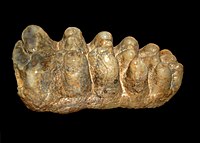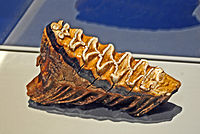Elephantidae
| Elephantidae Temporal range:
| |
|---|---|
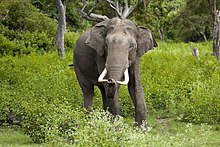
| |
| A maleAsian elephant(Elephas maximus) in the wild atBandipur National Parkin India | |
| Scientific classification | |
| Domain: | Eukaryota |
| Kingdom: | Animalia |
| Phylum: | Chordata |
| Class: | Mammalia |
| Order: | Proboscidea |
| Superfamily: | Elephantoidea |
| Family: | Elephantidae Gray,1821 |
| Type genus | |
| Elephas | |
| Genera[3] | |
| |
| Synonyms[4] | |
| |
Elephantidaeis afamilyof large, herbivorousproboscideanmammals collectively calledelephantsandmammoths.These are largeterrestrialmammalswith asnoutmodified into atrunkandteethmodified intotusks.Mostgeneraandspeciesin the family areextinct.Only two genera,Loxodonta(African elephants) andElephas(Asian elephants), areliving.
The family was first described byJohn Edward Grayin 1821,[5]and later assigned to taxonomic ranks within the order Proboscidea. Elephantidae has been revised by various authors to include or exclude other extinct proboscidean genera.
Description
[edit]Elephantids are distinguished from more primitive proboscideans likegomphotheresby their teeth, which have parallel lophs, formed from the merger of the cusps found in the teeth of more primitive proboscideans, which are bound bycement.[6]In later elephantids, these lophs became narrow lamellae,[7]with the number of lophs/lamellae per tooth, as well as the tooth crown height (hypsodonty) increasing over time.[8]Elephantids chew using a proal jaw movement involving a forward stroke of the lower jaws, different from the oblique movement using side to side motion of the jaws in more primitive proboscideans.[9]The most primitive elephantidStegotetrabelodonhad a long lower jaw with lower tusks and retained permanent premolars similar to many gomphotheres, while modern elephantids lack permanent premolars, with the lower jaw being shortened (brevirostrine) and lower tusks being absent.[8]
-
Molar ofTetralophodon,a "tetralophodontgomphothere"
-
Worn molar ofStegotetrabelodon,a primitive elephantid
-
Molar of a modernAfrican bush elephant(Loxodonta africana)
-
Tooth ofMammuthus sp.
-
Cross section through elephantid molars
Classification
[edit]
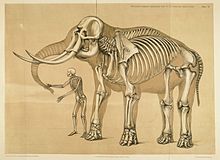

Some authors have suggested to classify the family into two subfamilies, Stegotetrabelodontinae, which is monotypic, only containingStegotetrabelodon,and Elephantinae, containing all other elephantids.[8]Recent genetic research has indicated thatElephasandMammuthusare more closely related to each other than toLoxodonta,withPalaeoloxodonclosely related toLoxodonta.Palaeoloxodonalso appears to have received extensive hybridisation with theAfrican forest elephant,and to a lesser extent with mammoths.[10]
Living species
[edit]- Loxodonta(African)
- L. africanaAfrican bush elephant
- L. cyclotisAfrican forest elephant
- Elephas(Asiatic)
- E. maximusAsian elephant
- E. m. maximusSri Lankan elephant
- E. m. indicusIndian elephant
- E. m. sumatranusSumatran elephant
- E. m. borneensisBorneo elephant
- E. maximusAsian elephant
Classification
[edit]- Elephantidae
- †Stegotetrabelodon(4 species)
- SubfamilyElephantinae
- †Primelephas(2 species)
- Elephas(7+ species)
- †Stegoloxodon(2 species)
- Loxodonta(6 species)
- †Palaeoloxodon(14+ species)
- †Phanagoroloxodon(1 species)
- †Mammuthus(10 species)
- †Stegodibelodon(1 species)
- †Selenetherium(1 species)
Evolutionary history
[edit]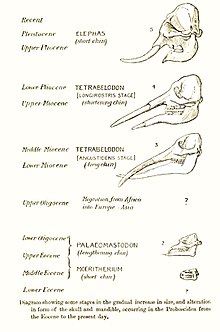
Elephantids are thought to have evolved fromgomphotheres,with some authors proposing the most likely ancestors to be African species of the "tetralophodont gomphothere"Tetralophodon.[11]The earliest members of the family, are known from the Late Miocene, around 9–10 million years ago.[12]The modern genera of elephants and mammoths had diverged from each other by the end of the Miocene, around 5 million years ago. Elephantids began to migrate out of Africa during the Pliocene, with mammoths andElephasarriving in Eurasia around 3–3.8 million years ago.[13]Around 1.5 million years ago, mammoths migrated into North America.[14]At the end of the Early Pleistocene, around 0.8 million years ago,Palaeoloxodonmigrated out of Africa, becoming widespread across Eurasia, from Western Europe to Japan.[15]PalaeoloxodonandMammuthusbecame extinct during theLate Pleistocene-Holocene,with the last population of mammoths persisting onWrangel Islanduntil around 4,000 years ago.[16]
See also
[edit]References
[edit]- ^H. T. Mackaye, M. Brunet, and P. Tassy. 2005.Selenetherium kolleensisnov. gen. nov. sp.: un nouveau Proboscidea (Mammalia) dans le Pliocène tchadien.Geobios38(6):765-777
- ^Kalb, J. E.; & Froehlich, D. J. (1995). "Interrelationships of Late Neogene Elephantoids: New evidence from the Middle Awash Valley, Afar, Ethiopia".Geobios.28(6): 727–736.Bibcode:1995Geobi..28..727K.doi:10.1016/s0016-6995(95)80068-9.
- ^Shoshani, J.; Ferretti, M.P.; Lister, A.M.; Agenbroad, L.D.; Saegusa, H.; Mol, D.; Takahashi, K. (2007). "Relationships within the Elephantinae using hyoid characters".Quaternary International.169–170: 174–185.Bibcode:2007QuInt.169..174S.doi:10.1016/j.quaint.2007.02.003.
- ^Maglio, Vincent J. (1973). "Origin and Evolution of the Elephantidae".Transactions of the American Philosophical Society.63(3): 16.doi:10.2307/1006229.JSTOR1006229.
- ^Gray, John Edward (1821)."On the natural arrangement of vertebrose animals".London Medical Repository.15:297–310.
- ^Lister, Adrian M. (2013-06-26)."The role of behaviour in adaptive morphological evolution of African proboscideans".Nature.500(7462): 331–334.Bibcode:2013Natur.500..331L.doi:10.1038/nature12275.ISSN0028-0836.PMID23803767.S2CID883007.
- ^Saarinen, Juha; Lister, Adrian M. (2023-08-14)."Fluctuating climate and dietary innovation drove ratcheted evolution of proboscidean dental traits".Nature Ecology & Evolution.7(9): 1490–1502.Bibcode:2023NatEE...7.1490S.doi:10.1038/s41559-023-02151-4.ISSN2397-334X.PMC10482678.PMID37580434.
- ^abcAthanassiou, Athanassios (2022), Vlachos, Evangelos (ed.),"The Fossil Record of Continental Elephants and Mammoths (Mammalia: Proboscidea: Elephantidae) in Greece",Fossil Vertebrates of Greece Vol. 1,Cham: Springer International Publishing, pp. 345–391,doi:10.1007/978-3-030-68398-6_13,ISBN978-3-030-68397-9,S2CID245067102,retrieved2023-11-21
- ^Saegusa, Haruo (March 2020)."Stegodontidae and Anancus: Keys to understanding dental evolution in Elephantidae".Quaternary Science Reviews.231:106176.Bibcode:2020QSRv..23106176S.doi:10.1016/j.quascirev.2020.106176.S2CID214094348.
- ^Palkopoulou, Eleftheria; Lipson, Mark; Mallick, Swapan; Nielsen, Svend; Rohland, Nadin; Baleka, Sina; Karpinski, Emil; Ivancevic, Atma M.; To, Thu-Hien; Kortschak, R. Daniel; Raison, Joy M. (2018-03-13)."A comprehensive genomic history of extinct and living elephants".Proceedings of the National Academy of Sciences.115(11): E2566–E2574.Bibcode:2018PNAS..115E2566P.doi:10.1073/pnas.1720554115.ISSN0027-8424.PMC5856550.PMID29483247.
- ^Geraads, Denis; Zouhri, Samir; Markov, Georgi N. (2019-05-04)."The first Tetralophodon (Mammalia, Proboscidea) cranium from Africa".Journal of Vertebrate Paleontology.39(3): e1632321.Bibcode:2019JVPal..39E2321G.doi:10.1080/02724634.2019.1632321.ISSN0272-4634.S2CID202024016.
- ^H. Saegusa, H. Nakaya, Y. Kunimatsu, M. Nakatsukasa, H. Tsujikawa, Y. Sawada, M. Saneyoshi, T. SakaiEarliest elephantid remains from the late Miocene locality, Nakali, KenyaScientific Annals, School of Geology, Aristotle University of Thessaloniki, Greece VIth International Conference on Mammoths and Their Relatives, vol. 102, Grevena -Siatista, special volume (2014), p. 175
- ^Iannucci, Alessio; Sardella, Raffaele (March 2023)."What Does the" Elephant-Equus "Event Mean Today? Reflections on Mammal Dispersal Events around the Pliocene-Pleistocene Boundary and the Flexible Ambiguity of Biochronology".Quaternary.6(1): 16.doi:10.3390/quat6010016.hdl:11573/1680082.ISSN2571-550X.
- ^Lister, A. M.; Sher, A. V. (November 13, 2015). "Evolution and dispersal of mammoths across the Northern Hemisphere".Science.350(6262): 805–809.Bibcode:2015Sci...350..805L.doi:10.1126/science.aac5660.PMID26564853.S2CID206639522.
- ^Lister, Adrian M. (2004),"Ecological Interactions of Elephantids in Pleistocene Eurasia",Human Paleoecology in the Levantine Corridor,Oxbow Books, pp. 53–60,ISBN978-1-78570-965-4,retrieved2020-04-14
- ^Arppe, Laura; Karhu, Juha A.; Vartanyan, Sergey; Drucker, Dorothée G.; Etu-Sihvola, Heli; Bocherens, Hervé (October 2019)."Thriving or surviving? The isotopic record of the Wrangel Island woolly mammoth population".Quaternary Science Reviews.222:105884.Bibcode:2019QSRv..22205884A.doi:10.1016/j.quascirev.2019.105884.hdl:10138/309133.S2CID203103403.
External links
[edit] Media related toElephantidaeat Wikimedia Commons
Media related toElephantidaeat Wikimedia Commons Data related toElephantidaeat Wikispecies
Data related toElephantidaeat Wikispecies

